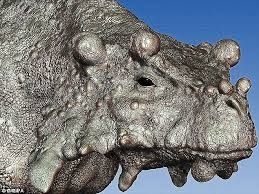Long before the dinosaurs, hefty herbivores called pareiasaurs ruled the Earth, some 260 million years ago.
Described as the ‘ugliest fossil reptiles’ pareiasaurs had small heads and stumpy limbs on barrel-shaped bodies covered in bony knobbles.
But despite their unattractive appearance and lumbering gait, a palaeontologist believes the huge herbivores were able to travel the world.
Professor Mike Benton studied fossils of all known Chinese specimens of pareiasaurs
Professor Benson has shown there are close similarities between Chinese fossils and those found in Russia and South Africa, indicating that the huge herbivores were able to travel around the world, or the supercontinent Pangea, despite their lumbering movement.
It seems clear there were three species and these lived over a span of one to two million years.’
Fully-grown Pareiasaurs measured between six-and-a-half and 10ft long (two to three metres) and had short, stocky arms and legs on their barrel-like bodies, which were covered in bony knobs.
It’s thought they lived in damp, lowland areas, feeding on huge amounts of low-nutrition vegetation with their small teeth.
No stomach contents or fossilized faeces from pareiasaurs are known to exist, but, pareiasaurs have been found with evidence they had made wallows in the soft mud probably to cool off or coat themselves in mud to ward off parasites.
The new study, confirmed that the three Chinese pareiasaur species differed from each other in body size and in the shapes of their teeth.
Professor Benton said: ‘My study of the evolution of pareiasaurs shows that the Chinese species are closely related to relatives from Russia and South Africa.
‘Despite their size and probably slow-moving habits, they could walk all over the world.
While pareiasaurs were the first truly large herbivores to walk the Earth, their tenure was short.
The end-Permian mass extinction killed off the pareiasaurs after they had been on Earth for only 10 million years.
Source: Daily mail
N.H.Kh

